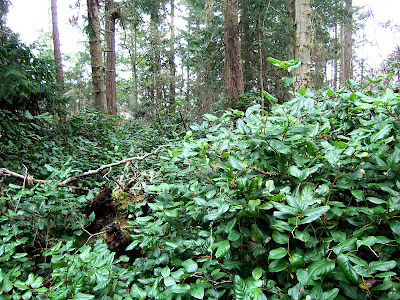Sam and I had to make a traverse through what I call old growth salal. Salal can be a dominant understory plant in the forest in areas that are droughtier - places that dry out in the summer. In this case we were in a drier part of western Washington in the rain shadow area of the Olympic Mountains. This stretch of salal was over 8 feet high in places but more typically 5 feet.
I have a distinct advantage over Sam in these situations. I can see over the top of the salal so I know where I am going. Sam being rather short is entirely dependent on me knowing where I am going. Also I have learned that when I get too tangled up I just roll over the salal to disengage my legs. A skill Sam has not figured out. But one advantage of salal compared to some other understory plants is it has no thorns.
Sam was much relieved when we reached an old logging road.
But note a few things about the logging road. The road is at least as old as the trees in the forest which I estimate to be 40 years to 50 years and has not been used for a very long time. The salal has not invaded the road and the road itself has sedges indicative of periodically saturated soils - a condition that salal does not care for.
The soil at this site consists of silty to clayey glacial drift. The upper soil is well enough drained to be a very good soil for salal. But where compacted the soil is poorly drained and forms a mini wetland or near wetland strip through an otherwise dry forest. Same soil just compacted makes a big difference in what will grow. In this particular case the soil is derived from weathered silty to clayey glacial marine drift.
Old growth salal
I have a distinct advantage over Sam in these situations. I can see over the top of the salal so I know where I am going. Sam being rather short is entirely dependent on me knowing where I am going. Also I have learned that when I get too tangled up I just roll over the salal to disengage my legs. A skill Sam has not figured out. But one advantage of salal compared to some other understory plants is it has no thorns.
Sam was much relieved when we reached an old logging road.
Sam finds the road a much easier route
But note a few things about the logging road. The road is at least as old as the trees in the forest which I estimate to be 40 years to 50 years and has not been used for a very long time. The salal has not invaded the road and the road itself has sedges indicative of periodically saturated soils - a condition that salal does not care for.
The soil at this site consists of silty to clayey glacial drift. The upper soil is well enough drained to be a very good soil for salal. But where compacted the soil is poorly drained and forms a mini wetland or near wetland strip through an otherwise dry forest. Same soil just compacted makes a big difference in what will grow. In this particular case the soil is derived from weathered silty to clayey glacial marine drift.




No comments:
Post a Comment